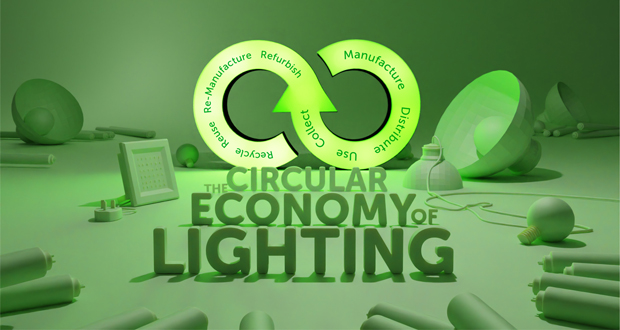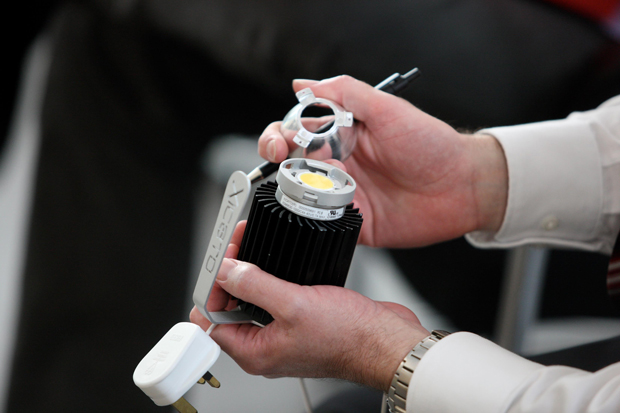
More and more lighting manufacturers are adding reconditioning to their business model, and FM companies have an opportunity to get involved. New standards and regulations are coming into force. Now is the time for all to embrace the drive to truly sustainable lighting. Nigel Harvey, Chief Executive of Recolight outlines the growth in remanufacturing in the Lighting Industry, and the challenges they face.
Reuse is a vital way in which users can reduce the carbon footprint of any lighting upgrades they require. Keeping existing light fittings in service reduces waste, improves material efficiency, and lowers the embedded carbon of new lighting.
One of the biggest barriers to reuse of lighting equipment has been the perception that customer demand is limited. Clients, both corporate and public sector, are however now warming to the concept of reconditioned lighting to achieve both sustainability goals and cost savings. And now tenders are beginning to emerge which specify the reconditioning and reuse of luminaires in a project. The more end users include reused or remanufactured product as an option in specifications, the more we will see producers offering these solutions.
As the trend gains traction, so facilities management companies will have the opportunity to get involved – either by dealing with a remanufacturer, or by setting up their own remanufacturing/repair/upgrade service.
Standards and regulations for remanufactured products
A BSI committee is working on a lighting version of BS8887, a standard for the remanufacture of luminaires. This standard will help companies remanufacture in a way that applies realistic approaches to product compliance and will give end users the confidence that the product is suitable for use.
Incentivise reuse and remanufacture
Government is already considering amending the WEEE regulations to recognise and reward remanufacture – possibly via a reduction in the WEEE financing obligations.
In situ or off-site
Remanufacture and upgrade can take place either on the owner’s premises, or at a third-party site. Where the work happens on-site, this clearly reduces the carbon footprint of the transport of equipment, and means that work can be scheduled to cause minimal interruption to the client. A number of companies can now provide or design upgrade kits for specific luminaire types, allowing FMs to provide a service that keeps the original fitting in use.
Output of the UK’s first conference dedicated to lighting equipment remanufacture
At a one-day special conference, hosted by Recolight in April this year, lighting experts discussed the opportunities and the challenges of remanufacturing lighting. With Ray Molony, Editor of Circular Lighting Report, noting that:
“It’s increasingly clear that the remanufacturing of luminaires is moving from the fringe of the industry to the mainstream, driven by the environmental priorities of clients and their specifiers. This is already a big, profitable sector, and it can only grow rapidly in the coming years.”
Delegates at the conference shared challenges they face with remanufacturing: Getting the message across about remanufacture, that it is not just about retrofit; that there are sometimes additional costs associated with remanufactured products; and helping end users understand the implications of remanufacturing rather than replacing Lighting.
There were many positives with delegates saying:
- Remanufacture is not just about cheap retrofits but the more important aspect is to save taking natural resources from the planet and putting them back into landfill at end of life.
- This is a developing segment and whilst at source it is about modifying habits for the greater global and environmental good, there are commercial opportunities to be explored. The increase in attendees demonstrates the significance of sustainability in both cases.
- The remanufacturing sector is quickly becoming formal and picking up pace. Leading lighting design professionals are on board with the concepts, message, and key terms. Models are still very much evolving. Remanufacturing is now a defined and suitable alternative to simply purchasing new products. The appetite and will to engage in remanufactured solutions is evident and regulations and standards are in the final phase of development to help deliver the confidence and certainty that a remanufactured product is safe, compliant and credible.
The challenges faced to implement a more sustainable, circular, business model, along with new regulations and standards will be included in the programme for the Circular Lighting Live conference and exhibition on 21 September in London.
Booking is now open, and tickets are available from www.circularlighting.live, email [email protected]
For more information on Recolight visit www.recolight.co.uk or call 0208 253 9750.
The post Lighting Industry gears for growth in remanufacturing appeared first on FMJ.








0 Comments